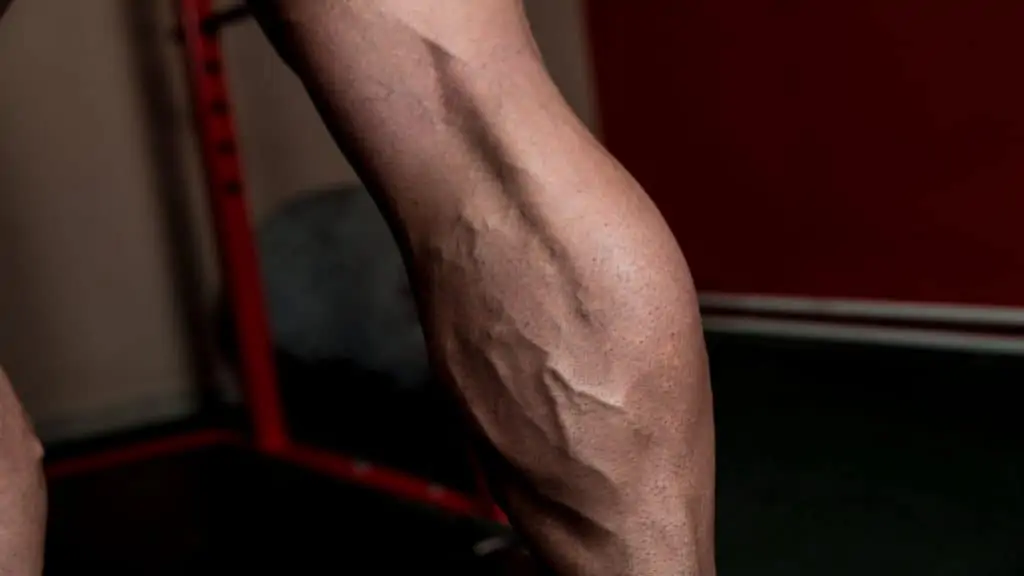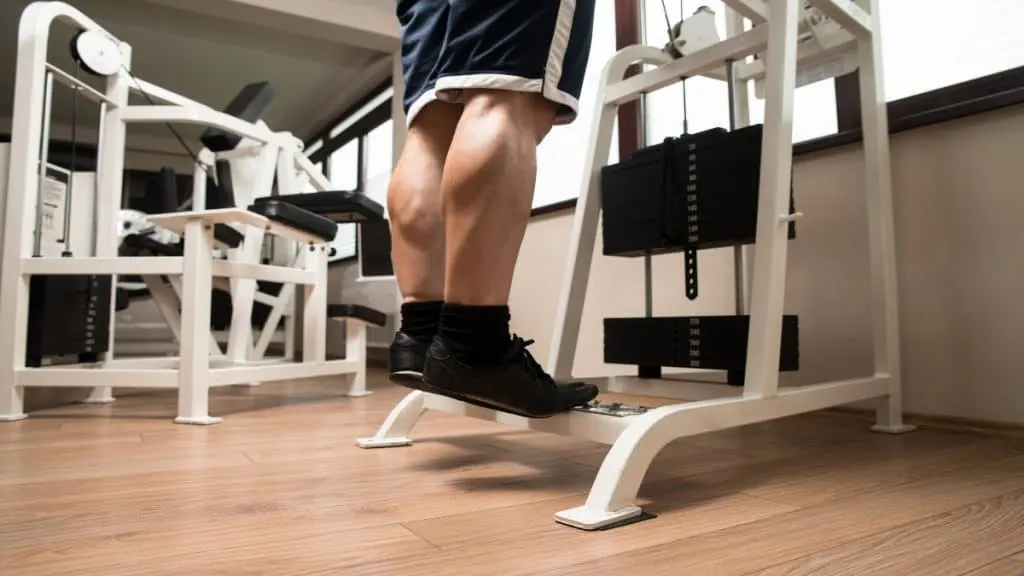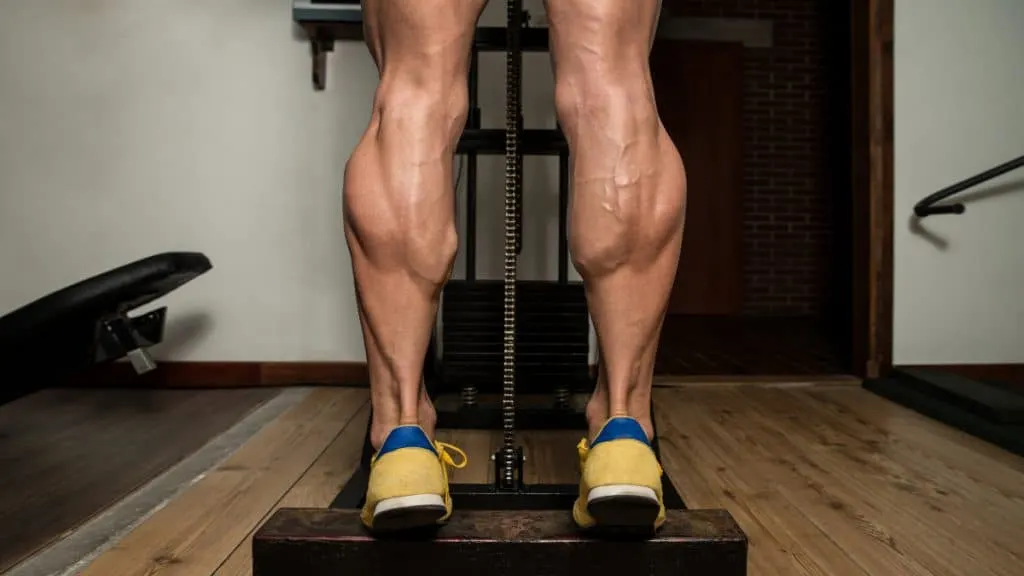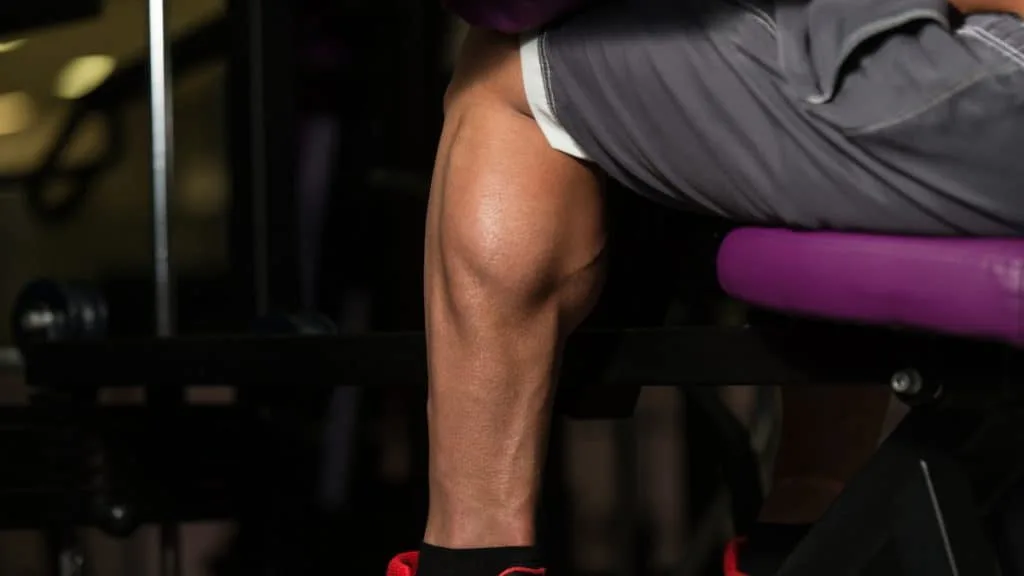This guide explains whether or not 16 inch calves are an average calf size for men and women of various heights and builds.
You’ll also learn how to grow your calves to more than 16 inches if that’s something you’re interested in.
See How Your Calves Stack Up:
- 11 inch calves
- 12 inch calves
- 13 inch calves
- 14 inch calves
- 15 inch calves
- 17 inch calves
- 18 inch calves
Are 16 inch calves good for males?

Are 16 inch calves big for a man?
Yes, in general, lean 16 inch calves are big for a man who lifts weights regularly.
Of course, the learner that you are, the more impressive your 16″ calves will look since they’ll be comprised of more muscle and less fat. [1]
For most gym-goers, building 16 in calves is a common physique goal and one that, when achieved, will most definitely spare you from the “skipped leg day” jokes.
The smaller your ankles are, the larger your 16 inch calves will look.
This is because those with smaller ankles (who also tend to be shorter in stature) typically have less ability to grow their calves because they simply have less bone mass to store additional calf muscle.
It’s also the reason why a short person with 16″ calves will always have more muscular lower legs than a tall person with 16″ calves—the short person’s calves are more filled out and closer to their genetic potential.
Are 16 inch calves normal for females?

In general, 16 inch calves are slightly bigger than average for females, but only by half an inch or so. [2]
If you’re an active woman and/or play sports, then your calves will likely be bigger and more muscular than those of someone who’s more sedentary (unless that person is overweight).
This is because your calves have to contract to some extent in order to support your body weight as you walk, run, jump, skip, or reach for the tall shelf at the grocery store.
Similarly, if you’re a tall woman, in which case you’ll have a relatively large bone structure, then you may also have 16 in calves.
Additionally, many women tend to store a majority of their body fat on their legs, which is one reason why men and women have very similarly sized calves in the general population.
How about 16.5 inch calves?

16.5 inch calves are pretty big for both men and women. Unless you’re genetically gifted with muscular lower legs or have excess body fat, you’ll really need to work your calves in order to get them to the 16.5 inch mark.
Since lean 16 inch calves are already good for an athlete or natural weight lifter, it can take longer than people think to add another half-inch to your lower legs.
Below you’ll find some proven strategies to get 16 in calves if you don’t already have them as well as tips to exceed them if you do.
How to increase your 16 inch calf circumference
If you don’t yet have 16 inch calves and want to build your lower legs, or if you already have 16″ calves and want to make them even bigger, be sure to implement these training tips to maximize your results.
Heavy weight training

Most people don’t realize it, but whenever you walk around, you are training your calves. This is especially true—particularly for the tibialis, the muscle on the front of your shin—if you’re walking for more than an hour. [3]
The point is that, unless you’re a couch potato or spend too much time at your desk, your calves are already used to supporting your body weight for prolonged periods of time.
As such, doing a few sets of bodyweight calf raises is about as useful for developing your calves as trying to build your biceps by lifting cups of coffee. It’s not going to happen.
Instead, focus on breaking down those gastrocnemius and soleus muscle fibers by challenging them with heavy mechanical tension.
Heavy weight training is a completely different calf stimulus than walking and playing sports.
It’s also the best way to track the effectiveness of your training—if you can calf raise more weight than you could a few months ago, then there’s a good chance that your calves have grown.
High rep pump work

Don’t worry if you don’t have access to free weights or specific calf machines. You can still grow your calves to 16 inches and beyond with nothing more than high rep bodyweight calf raises.
While bodyweight training isn’t my preferred method for building the calves, some people actually get better results from hammering their calves with light weights and tons of volume.
Best of all, for those who train at home, all you need is a step and a spare 5 minutes.
The idea is to rep out your calf raises until your calves feel like they’re on fire (one more reason why I prefer low or moderate reps—high rep calf raises burn!).
When you’re just lifting your body weight, it’s crucial to train close to failure so that all of the muscle fibers get recruited. So don’t just stop because the lactic acid is kicking in; keep going until your calves are 1-2 reps away from muscular failure.
Bulk up to a higher body weight

Have you ever noticed how people with more body mass—even overweight folk—have bigger and more muscular calves than people with slimmer physiques?
The main reason for this is that when you gain bodyweight, some of it inevitably goes to your calves even if you don’t train them directly.
Additionally, if you gain 20 lbs, then that’s an extra 20 pounds that your calves now have to support on a daily basis. If you do a lot of walking, this extra body mass could make your calves work a lot harder than usual, which would result in more growth over time.
Additionally, bulking up and eating in a calorie surplus typically makes you stronger in the weight room. Besides helping you to set new bench press and squat PRs, this extra fuel can give you the energy to train your calves harder and make them grow bigger.
This training intensity is crucial because the calves are a notoriously stubborn muscle group for many lifters. So while decent calves are usually pretty easy to maintain, you typically have to hammer your calves if you want them to grow to 16 inches and beyond.
Conclusion: How good are 16 inch calves?

A 16 inch calf measurement is definitely above average for both men and women. Whether 16 inch calves are good or not, however, depends on your goals and personal opinion.
For example, if you’re really tall, let’s say 6’3″, and have 16 inch calves, then your calves might actually look smaller than 16 inches simply because your legs are so long. Whether this kind of appearance is desirable is mainly down to personal opinion.
On the other end of the spectrum, if you’re 5’5″ with 16″ calves, then your lower legs will likely look very large.
Typically, most weight lifting men wish they had at least 16 inch calves, whereas many women with 16 in calves want to slim their lower legs down a bit. I guess you can’t please everyone.
References
- What Is Body Composition? (2021, June 4). WebMD. https://www.webmd.com/fitness-exercise/what-is-body-composition#1
- Centers for Disease Control and Prevention. (2008, October). Anthropometric Reference Data for Children and Adults: United States, 2003–2006 (No. 10). https://www.cdc.gov/nchs/data/nhsr/nhsr010.pdf
- Walking – Muscles Used. (2022). Physiopedia. https://www.physio-pedia.com/Walking_-_Muscles_Used

